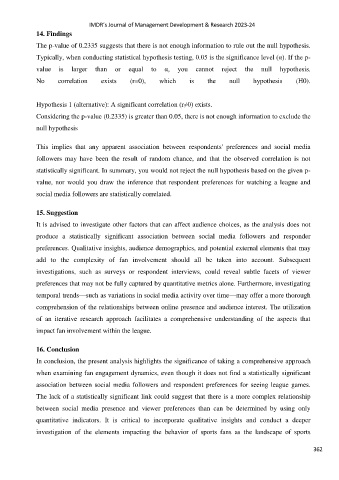Page 370 - IMDR JOURNAL 2023-24
P. 370
IMDR’s Journal of Management Development & Research 2023-24
14. Findings
The p-value of 0.2335 suggests that there is not enough information to rule out the null hypothesis.
Typically, when conducting statistical hypothesis testing, 0.05 is the significance level (α). If the p-
value is larger than or equal to α, you cannot reject the null hypothesis.
No correlation exists (r=0), which is the null hypothesis (H0).
Hypothesis 1 (alternative): A significant correlation (r≠0) exists.
Considering the p-value (0.2335) is greater than 0.05, there is not enough information to exclude the
null hypothesis
This implies that any apparent association between respondents' preferences and social media
followers may have been the result of random chance, and that the observed correlation is not
statistically significant. In summary, you would not reject the null hypothesis based on the given p-
value, nor would you draw the inference that respondent preferences for watching a league and
social media followers are statistically correlated.
15. Suggestion
It is advised to investigate other factors that can affect audience choices, as the analysis does not
produce a statistically significant association between social media followers and responder
preferences. Qualitative insights, audience demographics, and potential external elements that may
add to the complexity of fan involvement should all be taken into account. Subsequent
investigations, such as surveys or respondent interviews, could reveal subtle facets of viewer
preferences that may not be fully captured by quantitative metrics alone. Furthermore, investigating
temporal trends—such as variations in social media activity over time—may offer a more thorough
comprehension of the relationships between online presence and audience interest. The utilization
of an iterative research approach facilitates a comprehensive understanding of the aspects that
impact fan involvement within the league.
16. Conclusion
In conclusion, the present analysis highlights the significance of taking a comprehensive approach
when examining fan engagement dynamics, even though it does not find a statistically significant
association between social media followers and respondent preferences for seeing league games.
The lack of a statistically significant link could suggest that there is a more complex relationship
between social media presence and viewer preferences than can be determined by using only
quantitative indicators. It is critical to incorporate qualitative insights and conduct a deeper
investigation of the elements impacting the behavior of sports fans as the landscape of sports
362

